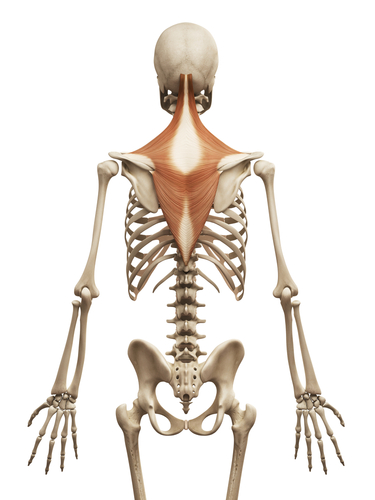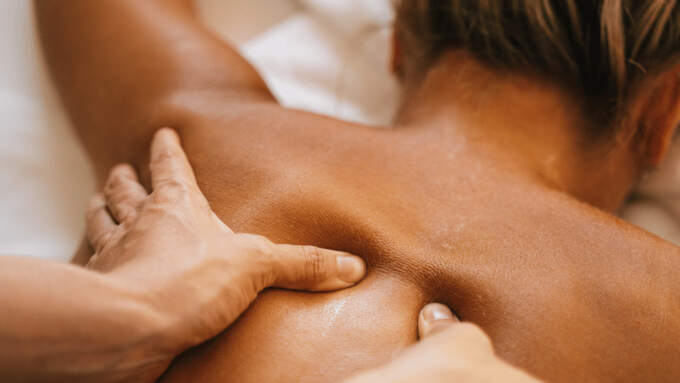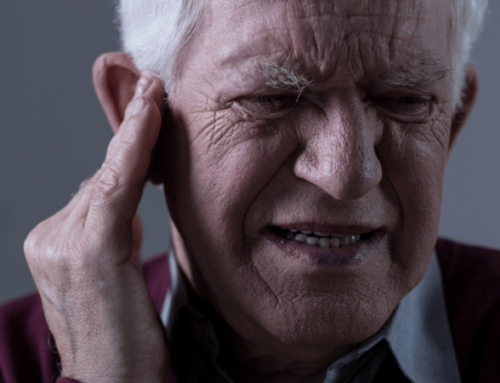Trapped in Pain?
The Trapezius Muscle

The trapezius muscle is the muscle that most commonly has trigger points and tension in it. Trigger points in the upper trapezius can cause tension headaches, neck aches, and even toothaches. When someone has a stiff neck and shoulder pain it is commonly coming from the trapezius, levator scapulae, and infraspinatus. You may want to check out the rhomboid as well.
Myofascial trigger points in the lower trap can cause soreness at the base of the skull and also at the top of the shoulder blades as well as a burning sensation between the scapula and spine.
The trapezius is responsible, along with other muscles, for elevation, depression, and adduction of the scapula as well as extension of the head, cervical and thoracic spine.
What Is A Trigger Point?
A trigger point, often described as a “knot” within our soft tissues, is more than just a tight spot in a muscle. It’s a manifestation of chronic physical stress, a painful cluster of muscle fibers that can disrupt our daily physical activity. These tight knots, common causes of discomfort, can exhibit several distinct characteristics. They might cause referred pain, radiating discomfort to other parts of your body. Some might elicit a twitch reflex when prodded, while others can induce severe pain upon compression, a clear sign of underlying tension. Such trigger points can be a result of various risk factors, from psychological stressors to physical threats. They can lead to tension-type headaches or even be the underlying cause of pain in the neck. Addressing these muscle knots is crucial, not just for the affected muscle but for the well-being of the entire body.
Anatomy & Importance: Meet the Trapezius Muscle
Ever heard of the trapezius muscle? Often just called the “traps,” it’s that large, kite-shaped muscle that starts at the base of your skull, stretches down your neck, fans out across your shoulders, and reaches the mid-back. It’s kind of a big deal.
Here’s a quick breakdown:
- Upper Trapezius: This top section helps you shrug and turn your head. So, every time you’re nodding along to your favorite song or looking around to catch a friend’s attention, it’s the upper traps doing the heavy lifting.
- Middle Trapezius: Located across your upper back, this part is all about pulling those shoulder blades together. Think of it as the muscle that’s got your back, literally, especially when you’re trying to stand tall and proud.
- Lower Trapezius: Running vertically down your back, this section helps keep your shoulder blades down. It’s the unsung hero when you’re reaching up or stretching out.
Now, beyond these daily moves, the trapezius plays a crucial role in our overall well-being. It’s closely connected to the cervical spine (that’s the neck region of your spine) and lies near the spinal cord. This means that any tension or issues in the trapezius can influence your neck and the nerve signals traveling between your brain and body.
In essence, the trapezius isn’t just about flexing or shrugging; it’s central to many of our daily activities and overall spinal health. So, whether you’re turning, reaching, or just sitting up straight, remember to give a nod to your hardworking trapezius!

Why Does the Trapezius Get Tight? Causes of Trapezius Pain
One of the biggest causes of trapezius pain is sitting in an unsupported, tense position. This will cause burning trapezius pain down your upper back. To fix this problem you must sit with proper back support, the right height of armrests, the right height of a keyboard, and take frequent breaks to move your shoulders. Every joint should be at 90 degrees.
Some other things that can cause chronic trapezius pain are heavy clothing, such as a misfitting overcoat or a heavy purse or a bra strap, sudden trauma like falling off a horse or down stairs, or a car accident. A small hemipelvis or different leg lengths can cause or perpetuate trigger points here because of the constant tilt of the shoulder girdle. Being anxious, long telephone calls, playing the violin, a high keyboard, a cane that is too long. armrests that are too high, constant flicking of the hair out of the face or a heavy backpack will all make you need a massage! A lot of people experience trapezius pain after sleeping in an awkward position as well.
If you tend to cross your arms, cradle your chin in your hand or put your hands in your pockets for relief. Schedule a massage appointment today!
If you have rounded shoulders or a forward head position, you likely have trigger points in the upper trapezius. So there are a few things you will need to work on. First stretching the trapezius to increase your range of motion, second stretching the pectoralis, and third strengthening the trapezius. These are covered in the videos below.
Stress, especially chronic stress, often takes a toll on our physical health, and the trapezius muscle is a common victim. When we’re under a lot of stress or facing emotional stress, our body’s stress response kicks in, causing physical symptoms like muscle spasm. The trapezius, crucial in our daily activities and closely linked to the cervical spine, becomes a hotspot for this tension. As we engage in repetitive movements, like hunching over desks or cradling phones, or even just bearing the weight of our mental health concerns, the “traps” can experience stress-related neck and shoulder tension. This tightness and pain can reduce blood flow, leading to tension headaches and even affecting our overall posture. So, if you’re feeling that chronic neck pain or shoulder tension, it might be high levels of stress manifesting in your trapezius.
 How to Fix Trapezius Muscle Pain
How to Fix Trapezius Muscle Pain
Do not sleep on a rubber pillow.
Do not get intensely preoccupied with what you are doing so you forget to move! This can tighten up your trapezius muscles and also your neck muscles.
Lean back against your chair.
Use the right keyboard and armrest height. Using the wrong height will lead to poor posture and make you experience neck pain.
Use a speaker phone.
Hold the steering wheel at the bottom with the forearm resting on the thigh.
Do not do the Justin Beiber hair flick.
Avoid sleeping on your stomach.
Do not wear a too-tight bra. This digs into your shoulders causing trapezius pain and muscle strain in the middle of the back.
Jump rope or swim instead of jog. Jogging can make you tighten your shoulders causing muscle spasms.
Use some sort of elbow rest when the arms must be held out in front of you for a long time.
Use a tennis ball or lacrosse ball to perform self-massage techniques to relieve muscle tightness and tender points.

Treatments for Trapezius Pain
Trapezius pain can be a real downer, affecting our daily activities and overall well-being. But the good news is, there are several effective treatments to help alleviate this discomfort:
- Massage Therapy: One of the best ways to address trapezius pain is through massage therapy. A skilled therapist at places like Body Ache Escape Massage Center can target tension knots, improve blood flow, and provide stress relief, helping to relax that tight muscle tissue and alleviate chronic pain.
- Chiropractic Care: Misalignments in the spine can contribute to trapezius and back pain. Chiropractors specialize in adjusting the spine to its proper position, which can provide relief from muscle tension and improve overall posture.
- Essential Oils: Nature offers remedies that can help with muscle tension and stress. Essential oils like lavender, eucalyptus, and peppermint have properties that can relax muscles and calm the mind when applied topically or diffused.
- Exercises: Strengthening and stretching exercises can be beneficial. Gentle neck stretches, shoulder rolls, and scapular squeezes can help improve flexibility and strength in the trapezius. It’s essential to consult with a physical therapist or fitness expert to ensure you’re doing exercises that benefit without causing further strain. Using a foam roller or trying dry needling can improve middle trapezius trigger points.
- Yoga: Yoga poses like the child’s pose or the ragdoll pose are great stretches to relieve tension in the shoulder area.
- Heat and Cold Packs: Alternating between heat and cold therapy can help reduce inflammation and soothe muscle tension. Cold packs can numb the affected area and reduce swelling, while heat can relax tense muscles and improve blood supply.
- Posture Correction: Maintaining good posture, especially if you’re sitting for long periods of time, can prevent and alleviate trapezius pain. Ergonomic chairs, standing desks, and regular breaks to stretch can make a significant difference.
- Relaxation Techniques: Stress is a common cause of trapezius tension. Techniques like progressive muscle relaxation, deep diaphragmatic breathing exercises, and even meditation can help reduce stress levels and, in turn, muscle tension.
- Over-the-counter Pain Relievers: For some, non-prescription pain relievers like ibuprofen can help reduce pain and inflammation. However, it’s essential to use oral medication as directed and consult with a healthcare provider if you’re unsure.
In conclusion, while trapezius pain can be bothersome, a combination of treatments can provide relief. It’s essential to listen to your body, seek expert advice, and find what perfect combination of therapies works best for you. Remember, your well-being is worth the effort!
In the hustle and bustle of daily activities, it’s easy to overlook the physical symptoms our bodies exhibit due to high levels of stress. From tension headaches to chronic neck pain, the signs are clear: our trapezius and surrounding shoulder muscles are crying out for relief. Good news! One of the best ways to alleviate this tension and improve blood flow is through massage therapy. At Body Ache Escape Massage Center, our expert massage therapists understand the intricate connection between mental health and physical pain. Don’t let stress-related neck and shoulder tension dictate your well-being. Take control, prioritize your health, and schedule a massage with us today. Your body will thank you!
More Articles To Read
Deep Shoulder and Elbow Pain
7 Tips for Shoulder Blade Pain
Dupuytrens Contracture
Chron’s Disease
 How to Fix Trapezius Muscle Pain
How to Fix Trapezius Muscle Pain



